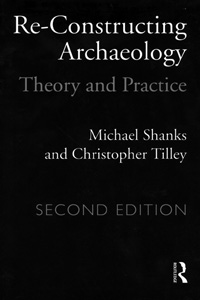Routledge 1992 - Second Edition

A major reassessment of what archaeology is all about and how it goes about working on the past.
Sometimes called "the black book"
Widely denounced in archaeology. But it is still available and has had quite an influence.
Why were Chris and I so controversial?
Because we mingled science with politics and business. We argued that archaeology is primarily about our relationship with the past. Archaeology is not about the past so much as where we come from. This makes it ethically and politically important to people, because the past is often where we look for roots and a sense of self and identity. Here we were connecting archaeology with the growing heritage industry and arguing that archaeological scientists do not have an overriding claim on the past. Archaeology is just another part of a growing interest in the material past that also includes commercial, state, and personal interests in tourism and collection, for example. It is a powerful claim to want to build scientific knowledge of the past, but not one to be pursued to the exclusion of other interests. In arguing that archaeologists should take seriously their responsibilities to contemporary society, we were seen as political pundits rather than disinterested scientists. But we were proved to be spot on in our diagnosis of archaeology. Since the 1980s legislation has been introduced the world over to ensure respect for plural and different interests in the past. In the United States, for example, Native American spiritual claims on the remains of the past have to be respected. Heritage is seen now as a human right. Cultural tourism, focusing on collections and archaeological sites, has become a massive economic sector. We were laying the intellectual ground for understanding these changes.
Because we went against anthropological orthodoxy. We criticized ideas of cultural evolution--that history is a progression of social forms that evolve through evolutionary processes such as adaptation to environment. This has been the main anthropological view of human history for two centuries. Instead, we built our ideas on a broader base of social theory and philosophy. The result, only achieved after some twenty years of further research, is a picture of the main events in human history that is quite different to the old orthodoxy. And this is the subject of my new book "Origins - how new archaeological thinking is changing the way we understand history".
Because we proposed another more historical model of the past that includes intangibles like the way people think. In place of orthodox cultural evolution we developed what I call an archaeology of mind that sees a major role in long term history for cultural factors such as spirituality, ritual, cult, ideology, and senses of identity, while nevertheless emphasizing, as an archaeology, the importance of people's relationships with things. This actually amounts to a different model of human nature.
Because we argued for a new interdisciplinary field centered upon material culture and design. We argued that what people do with things often tells you more than what people say. Nobody had noticed that beer cans were different in Sweden and the UK; and that they had to be different . We connected beer can design with all kinds of attitudes towards alcohol in the UK and Sweden in the 1980s, and even came up with an explanation for why the colors of cans and what is written on them differ in the two countries. Studying the cans led us into unspoken assumptions about two very different cultures of drink. But the argument was much bigger. It was that in spite of our contemporary obsession with goods, there was actually no discipline that dealt with understanding things. Twenty years later we have design studies, material culture studies, cognitive science and HCI (human-computer interaction), even garbology (archaeologists digging up land fill sites in order to understand contemporary society).
Here are the chapters of the book in editable PDF (this means that there are a few mistakes as a result of OCR)
 02-Positivism-New-Archaeology.pdf
02-Positivism-New-Archaeology.pdf
 05-Hermeneutics-Dialectics.pdf
05-Hermeneutics-Dialectics.pdf
